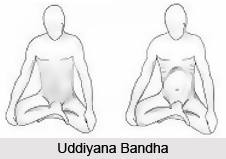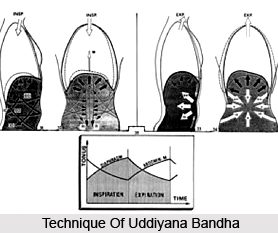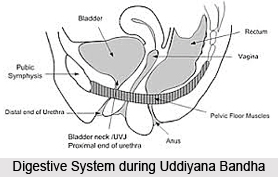 Uddiyana bandha is a technique, which makes maximum use of the diaphragm and the ribs. It is practiced either in sitting or in standing position. This practice also forms the basis for nauli kriya. Different technical terms related to this practice are in vogue. Although the technique and the application of these practices vary, they have a common characteristic feature that is the ascending movement of the diaphragm.
Uddiyana bandha is a technique, which makes maximum use of the diaphragm and the ribs. It is practiced either in sitting or in standing position. This practice also forms the basis for nauli kriya. Different technical terms related to this practice are in vogue. Although the technique and the application of these practices vary, they have a common characteristic feature that is the ascending movement of the diaphragm.
If uddiyana bandha is to be practiced in sitting position, one has to sit in Padmasana and place the palms on the knees. In standing position one has to bend little forward, bend the knees slightly and rest one`s hands either on the thighs or on the knees. Legs are kept apart. Position of the hands is not only important as a support but also because it facilitates the action of the thoracic cage and fixes up the neck and the shoulder muscles properly. After adapting the right type of posture, the practitioner should exhale deeply for uddiyana. The help of strong abdominal contraction can be taken for maximum deep exhalation. The breath is held out and a strong mock inhalation is attempted, i.e., the chest is expanded by raising the ribs as if inhalation is taking place. Actually the air is not allowed to flow into the lungs. For this, even nostrils are closed in the beginning. The abdominal muscles are kept relaxed. Thus during the mock inhalation the atmospheric air does not enter the lungs but the chest is expanded like it is inflated in the normal inhalation. Due to this, there is a sharp increase in the negative pressure in the thoracic cavity, which creates a suction gradient towards the diaphragm. The diaphragm is lifted up and the whole abdomen is sucked in towards the diaphragm and the spine, giving it a concave shape.
Bending position of the body helps in giving greater abdominal concavity. This condition is to be maintained till one develops a strong desire to breathe in. To release uddiyana, the chest is relaxed and the abdominal wall is allowed to come to its normal position gradually and passively and at the same time inhaling slowly. This is one round of uddiyana bandha. The optimum duration of one round is possible from 10 to 60 seconds. When one gets mastery over uddiyana with a longer duration, nauli kriya becomes easier. Such three to four rounds are practiced at a stretch, with or without the normal breathing in between the two rounds. Uddiyana bandha is to be practiced on an empty stomach and bladder.
 It may be remembered that during normal inhalation the diaphragm moves down when the chest is expanded. But in uddiyana bandha, the diaphragm is moving up even though the chest is expanding as usual. Therefore anatomically, `uddiyana` means the rising up of the diaphragm and `bandha` means the neuromuscular locking (action) at the navel region. It is this anatomical position of the diaphragm and the abdominal muscles, which enables one to experience peculiar sensations along the spine, due to stretching of the lower portion of the lumbar part of the vertebral column and the particular angle taken by the sacrum. As stated earlier, the yogic practices thus stimulate the sacral region, which is innervated by the parasympathetic nervous system.
It may be remembered that during normal inhalation the diaphragm moves down when the chest is expanded. But in uddiyana bandha, the diaphragm is moving up even though the chest is expanding as usual. Therefore anatomically, `uddiyana` means the rising up of the diaphragm and `bandha` means the neuromuscular locking (action) at the navel region. It is this anatomical position of the diaphragm and the abdominal muscles, which enables one to experience peculiar sensations along the spine, due to stretching of the lower portion of the lumbar part of the vertebral column and the particular angle taken by the sacrum. As stated earlier, the yogic practices thus stimulate the sacral region, which is innervated by the parasympathetic nervous system.
The main physiological characteristic feature of uddiyana bandha is that it produces sub-atmospheric (negative) pressures inside the visceral cavities like oesophagus, stomach, urinary bladder and colon. This vacuum creation is mainly due to the ascending movement of the diaphragm, irrespective of the movement of the ribs during the expansion of the thoracic cage. This vacuum production would promote blood circulation in the pelvic region. This will tone up the plexuses in this part and will stimulate the parasympathetic nerve fibers. A sincere practitioner would experience the special type of sensations along the spinal cord.
The physical benefits of uddiyana bandha are numerous. The tone and the strength of the abdominal muscles are well maintained by this bandha. This bandha prevents congestion in the pelvic region and relieves constipation, as it improves liver function and digestion. It mobilizes the extra fat deposition on the abdominal wall. It has been observed that uddiyana bandha produces sinus bradycardia (reduction in the heart rate), which may be due to the negative pressure, created in the thorax.
In uddiyana bandha, flying up of the diaphragm is the main feature. The mock inhalation is done by expanding the chest after the deepest possible exhalation. Since the abdominal muscles remain in relaxed condition, the whole abdomen is lifted up and inward. Negative intra-thoracic and intra-gastric pressures are created. Suction is felt near the center of the diaphragm, the pelvic region and lower abdomen. The whole technique becomes very easy after some practice and one does not feel exerted. Main objective of the practice is the stimulation of the nerves in the sacral region and to produce typical state of consciousness. Unless this technique is mastered nauli manipulation is not possible.
Thus it would be clear that the sensory aspect is more important in uddiyana bandha. One is expected to perceive these sensations rising up along the spinal cord from the lowermost portion of the trunk. Uddiyana bandha should be practiced cautiously since it produces bradycardia due to negative pressures in the viscera, and influences blood circulation as well as the endocrine function. Too much practice of uddiyana bandha, may give rise to constipation and the diaphragmatic or the chest pain.
 It should also be clear that the technique of uddiyana bandha as a preparation to nauli and the technique of uddiyana bandha practiced during Pranayama are different. In the former practice one has to exhale and hold the breath while in later one has to inhale and hold the breath. Naturally in the first one negative pressure is developed while in the second the positive pressure is created.
It should also be clear that the technique of uddiyana bandha as a preparation to nauli and the technique of uddiyana bandha practiced during Pranayama are different. In the former practice one has to exhale and hold the breath while in later one has to inhale and hold the breath. Naturally in the first one negative pressure is developed while in the second the positive pressure is created.
Somr precautions should be taken while practicing uddiyana bandha. It has been found that in an enthusiasm and due to lack of appropriate information about uddiyana bandha, many people practice some other techniques instead of uddiyana bandha. Two types of techniques are possible, namely, Mueller`s maneuver (MM) and Valsalva maneuver (VM) which may be practiced by mistake, instead of uddiyana bandha. This bandha should not be practiced if the person who is practicing this bandha has a complaint of headache.



